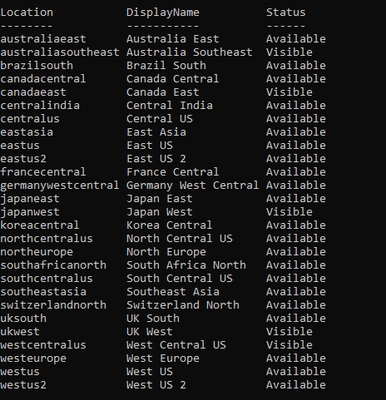
by Contributed | Jan 28, 2021 | Technology
This article is contributed. See the original author and article here.
This article describes to check your quota and what should be your next when you reach Synapse workspace default limit.
If you exceeds workspace limits the error message you receive is – “ReachedPerSubscriptionWorkspaceLimit: Reached the maximum number of workspaces allowed for Subscription”
Facts:
Current default limit is 20 Synapse workspaces per subscription/region. i.e. There is a limit of 20 SQL servers per subscription by default.
Check Details about your subscription and workspaces:
Get the details about the workspace created in your subscription. This will help to optimize your resources
- Check for workspaces created and regions available to the subscription.
Following are list Rest APIs for Synapse
Azure Synapse Analytics REST API Reference | Microsoft Docs
- Available Regions
Ref document: Providers – Get (Azure Resource Management) | Microsoft Docs
GET https://management.azure.com/subscriptions/{SuBGUID}/providers/Microsoft.Synapse?api-version=2020-06-01
- Workspaces List
Workspaces – List (Azure Synapse) | Microsoft Docs
GET https://management.azure.com/subscriptions/{subscriptionId}/providers/Microsoft.Synapse/workspaces?api-version=2019-06-01-preview
Run following script in PowerShell 7
$SubscriptionId ={SubscriptionId}
# ------------------------------------------------------------------
# first login to Azure Account
Write-Host "Connecting to Azure Account..."
if((Get-AzContext) -eq $null)
{
Connect-AzAccount
}
# set subscription context
Write-Host "Selecting subscription..."
$context = Set-AzContext -Subscription $SubscriptionId
# get AAD token for REST calls
Write-Host "Getting Bearer token from AAD for REST calls..."
$apiToken = [Microsoft.Azure.Commands.Common.Authentication.AzureSession]::Instance.AuthenticationFactory.Authenticate($context.Account, $context.Environment, $context.Tenant.Id, $null, "Never", $null)
$headers = @{ 'authorization' = ('Bearer {0}' -f ($apiToken.AccessToken)) }
# Get Locations where Synapse is available
Write-Host "Getting Locations where Synapse is available..."
$synapseLocations = Get-AzLocation | Where-Object { $_.Providers -contains "Microsoft.Synapse" } | Sort-Object Location | Select-Object Location, DisplayName
# ------------------------------------------------------------------------------
# get subscription quota and regional available SLOs for Synapse SQL
Write-Host "Getting subscription quota settings for Synapse..."
$quotaResults = [System.Collections.ObjectModel.Collection[psobject]]@()
foreach($location in $synapseLocations)
{
# ------------------
# available slos
# https://docs.microsoft.com/en-us/rest/api/sql/capabilities/listbylocation
$capabilitiesUri = "https://management.azure.com/subscriptions/$SubscriptionId/providers/Microsoft.Sql/locations/$($location.Location)/capabilities?api-version=2020-08-01-preview"
$regionalCapabilities = ConvertFrom-Json (Invoke-WebRequest -Method Get -Uri $capabilitiesUri -Headers $headers).Content
# ------------------------------------
$quotaResults += [PSCustomObject]@{
Location = $location.Location;
DisplayName = $location.DisplayName;
Status = $regionalCapabilities.status;
}
}
$quotaResults | ft -AutoSize
Sample output.

- Check details about usage matrix for SQL Pools
Workspace Managed Sql Server Usages – List (Azure Synapse) | Microsoft Docs
GET https://management.azure.com/subscriptions/{subscriptionId}/resourceGroups/{resourceGroupName}/providers/Microsoft.Synapse/workspaces/{workspaceName}/sqlUsages?api-version=2019-06-01-preview
Use following script in PowerShell 7
$SubscriptionId ={SubscriptionId}
# ------------------------------------------------------------------
# first login to Azure Account
Write-Host "Connecting to Azure Account..."
if((Get-AzContext) -eq $null)
{
Connect-AzAccount
}
# set subscription context
Write-Host "Selecting subscription..."
$context = Set-AzContext -Subscription $SubscriptionId
# get AAD token for REST calls
Write-Host "Getting Bearer token from AAD for REST calls..."
$apiToken = [Microsoft.Azure.Commands.Common.Authentication.AzureSession]::Instance.AuthenticationFactory.Authenticate($context.Account, $context.Environment, $context.Tenant.Id, $null, "Never", $null)
$headers = @{ 'authorization' = ('Bearer {0}' -f ($apiToken.AccessToken)) }
# ------------------------------------------------------------------------------
# SQL server DTU limits
Write-Host "Getting SQL DTU limits..."
# all servers in this subscription for SQL
# https://docs.microsoft.com/en-us/rest/api/sql/servers/list
# GET https://management.azure.com/subscriptions/{subscriptionId}/providers/Microsoft.Sql/servers?api-version=2019-06-01-preview
$serversUri = "https://management.azure.com/subscriptions/$SubscriptionId/providers/Microsoft.Sql/servers?api-version=2019-06-01-preview"
$serverList = (ConvertFrom-Json (Invoke-WebRequest -Method Get -Uri $serversUri -Headers $headers).Content).value
$serverQuotas = @()
foreach($server in $serverList)
{
# usage detail of indiviual server
# https://docs.microsoft.com/en-us/rest/api/sql/servers/usages
# GET https://management.azure.com/subscriptions/{subscriptionId}/resourceGroups/{resourceGroupName}/providers/Microsoft.Sql/servers/{serverName}/usages?api-version=2014-01-01
$serverQuotaUri = "https://management.azure.com$($server.id)/usages?api-version=2014-01-01"
$serverQuota = (ConvertFrom-Json (Invoke-WebRequest -Method Get -Uri $serverQuotaUri -Headers $headers).Content).value
$serverQuotas += [PSCustomObject]@{
Location = $server.location;
Id = $server.id;
Name = $server.name;
CurrentDTU = ($serverQuota | ? { $_.name -eq 'server_dtu_quota_current' }).currentValue;
DTULimit = ($serverQuota | ? { $_.name -eq 'server_dtu_quota_current' }).limit;
}
}
$serverQuotas | Sort-Object Location, Name | ft Location, Name, CurrentDTU, DTULimit -AutoSize
Sample result
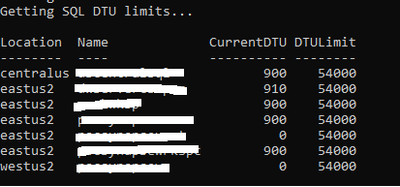
Next Step: If you want to increase the quota, feel free to contact us through @ support .
by Contributed | Jan 28, 2021 | Technology
This article is contributed. See the original author and article here.
Today, and every Wednesday Data Exposed goes live at 9AM PT on LearnTV. Every 4 weeks (mostly the first week of each month), we’ll do a News Update. We’ll include product updates, videos, blogs, etc. as well as upcoming events and things to look out for. We’ve included an iCal file, so you can add a reminder to tune in live to your calendar. If you missed the episode, you can find it at https://aks.ms/AzureSQLYT along with other videos.
Along with the News Update on Data Exposed Live, you can read this blog to get the guide and links to all the things discussed in the show. Here’s the February 2021 update:
Product updates
Confidential computing using Always Encrypted with secure enclaves went into public preview last week. This expands Always Encrypted by enabling in-place encryption and rich confidential queries, including pattern matching, range comparisons, and sorting. This announcement is available in the new DC-series hardware configuration in preview for Azure SQL Database. Jakub Szymaszek came on the show to explain more and show a demo. You can read more in the blog here.
Also related to security is the topic of Azure Defender for SQL. Over the past month, a few updates and enhancements were made to Azure Defender for SQL in the Azure Security Center:
A great resource which I have recently found is the Release notes for Azure Security Center. Not always related to SQL, but oftentimes relevant in some form or fashion.
Also slightly unrelated but at the same time very much related to Azure SQL was the announcement that Microsoft will establish a new datacenter region in Chile as part of a “Transforma Chile” initiative.
Microsoft recently released a website dedicated to the topic of .NET application migration. Of course, Azure SQL plays a big part here, so you might find the new site and resources interesting.
Alan Yu came on the show to talk about the latest updates to Azure Data Studio including some sneak peeks.
Videos
We continued to release new and exciting Azure SQL videos this month. Here is the list, or you can just see the playlist (https://aka.ms/dataexposedyt) we created with all the episodes!
- What is aka.ms/sqlworkshops? – Buck Woody
- [MVP Edition] Always Encrypted in SQL Server 2019 – Mladen Prajdic
- Azure SQL Connectivity Performance Tips & Tricks – Silvano Coriani
- Simplify Authentication with Managed Identities for Azure Resources – Silvano Coriani
- How to Troubleshoot Elastic Job in Azure SQL Database – Kate Smith
Blogs
As always, our team is busy writing blogs to share with you all. Blogs contain announcements, tips and tricks, deep dives, and more. Here’s the list I have of SQL-related topics you might want to check out.
- Azure Blog
- SQL Server Tech Community
- Azure SQL Tech Community
- Azure SQL Devs’ Corner
- Azure Database Support (SQL-related posts)
- Microsoft Learn Tech Community
- Chris Testa-O’Neill came on the show to talk to use about Microsoft Azure certification updates. This included the announcement of two new Data & AI related exams, DP-203 and AI-102. For more information, see the Microsoft Learn Blog with all the details.
Upcoming events
As always, there are lots of events coming up this month. Here are a few to put on your calendar and register for:
2/3: Data Exposed Special: The Azure SQL and Azure Data Factory engineering teams are partnering for an all-day learning event where the community can come together to learn about Azure SQL and Azure Data Factory, connect with the experts, and participate in a Hackathon, all across two time zones – America and Asia. Register today!
2/11: Azure Webinar Series: Gain Economic Value Migrating to Azure SQL
2/20: Multicloud4U
SQL Edge to Cloud, Bob Ward
2/27: Scottish Summit
Notebooks 101 for SQL People, Julie Koesmarno
In addition to these upcoming events, here’s the schedule for Data Exposed Live:
2/3: Around the Clock with Azure SQL & Azure Data Factory
2/10: Deep Dive: Best practices assessment for Azure SQL VMs, Managed Instances, and SQL Servers
2/17: Azure SQL Security: The What, Why & How of Securing your Data with Azure SQL
2/24: Something Old, Something New with Buck Woody
Plus find new, on-demand Data Exposed episodes released every Thursday, 9AM PT at aka.ms/DataExposedyt
Featured Microsoft Learn Module
Learn with us! This month I highlighted the Deploy and configure servers, instances, and databases for Azure SQL module. Check it out!
Anna’s pick of the month: SQL Server Virtual Conference by C# Corner
This pick of the month is technically in January, but it’s at the very end and it hasn’t happened yet, so here we are. This is an awesome, community-run event taking place this Friday. When you register, you can buy a ticket (for only $5!) or donate to a charity focused on helping food-insecure children related to COVID 19. I am a big fan of C# Corner already but using this event to help raise money for the kids is special. Additionally, the SQL Server and Azure SQL product group leader, Asad Khan, will be delivering the keynote! Get your tickets here, the event is January 29-30th.
Until next time…
That’s it for now! Be sure to check back next month for the latest updates, and tune into Data Exposed Live every Wednesday at 9AM PST on LearnTV. We also release new episodes on Thursdays at 9AM PST and new #MVPTuesday episodes on the last Tuesday of every month at 9AM PST at https://aka.ms/dataexposedyt.
Having trouble keeping up? Be sure to follow us on twitter to get the latest updates on everything, @AzureSQL. You can also download the iCal link with a recurring invite!
We hope to see you next time, on Data Exposed!
–Anna and Marisa

by Contributed | Jan 28, 2021 | Technology
This article is contributed. See the original author and article here.
Event-driven architecture has become popular for its ability to ingest, process, and react to events in real-time. Event-driven is not a new paradigm however the proliferation of microservices and serverless computing has led to its ability to fully realize the benefit of its loosely coupled design to reach infinite scale without the need to manage infrastructure.
Moving to an event-driven architecture requires a restructuring of how you think about your application. To adopt an event-first mindset, you should first consider what business processes could be optimized to deliver customer value. These business processes can then be distilled down to a workflow of events.
What is an event?
An event is a lightweight notification of a condition or a state change that occurs in your environment. Events are produced from event sources where the state change has taken place. Events exist in many forms from checking code into source control or hiring a new employee and now several actions need to follow.
What is event-driven architecture?
Event-driven architecture is a distributed system pattern that uses events to communicate between loosely coupled microservices to produce highly scalable applications. An event-driven architecture consists of event producers that generate a stream of events, and event ingestion that processes messages to the appropriate event consumers. Producers and consumer services are decoupled, which allows them to be scaled, updated, and deployed independently.

Polling based vs event-driven architectures
In a polling based architecture when you want to respond to events it can be difficult to discover those events, often you must write specific code across different API’s and SDK’s to continuously poll, looking for changes from the desired event source. Polling based architectures are synchronous so clients must wait for initial processes to complete before it can move onto the next one.
In an event-driven architecture, events are processed asynchronously which keeps threads running independently, instead of having to wait for a reply before moving onto the next task. One of the best practices for event driven architectures is using an event broker. Event producers and event consumers aren’t tightly coupled, so you can change producers and consumers just by communicating with the broker.
Azure Event Grid is the event broker backplane that enables event-driven, reactive programming. You can publish any event to event grid, add consumers to event grid and lower costs by eliminating the need for constant polling. Event grid is serverless so you get the benefits of publishing and subscribing to messages without the overhead of setting up the necessary infrastructure.
Since event-driven architectures are composed of loosely coupled distributed services, serverless application components can react to events in near real-time with virtually unlimited scalability. Services such as Azure Functions or Logic Apps easily integrate with Event Grid allowing you to build serverless event-driven applications.
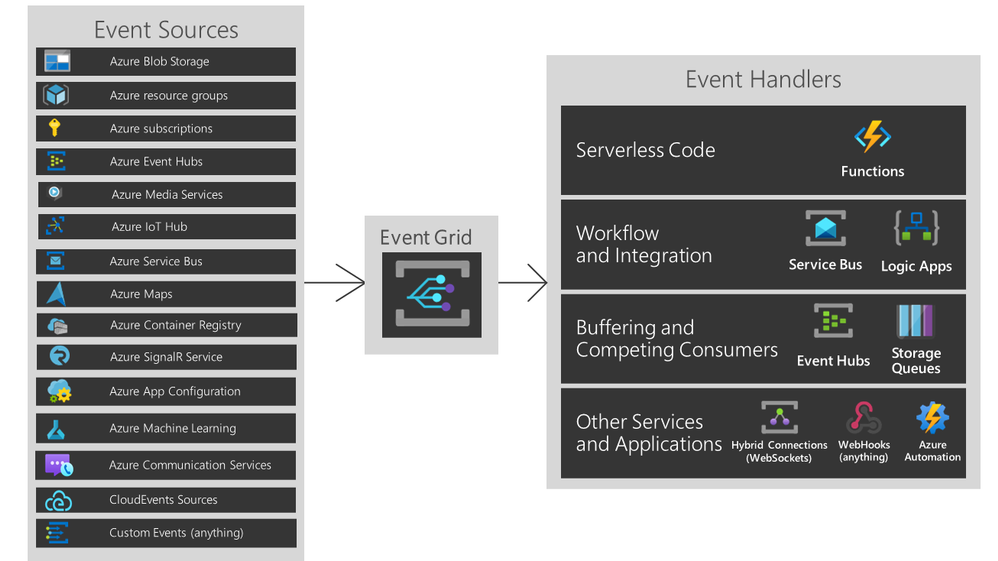
What are the benefits of event-driven?
- Loosly coupled: can add, remove, version as your architecture grows. You can easily add in a new event consumer and the other ones don’t have to know about it
- Highly composable: can use and reuse different event driven components throughout your solution
- “Single purpose” units of code: Event driven architecture can help you keep your code from getting too complex by breaking into more discrete parts
- Maps to the business need: Your team is building code based off of the actual business events. “When a sale happens” is the event, so what should happen when a sale happens? Ideally the real world events are represented in your solution.
Example Scenario
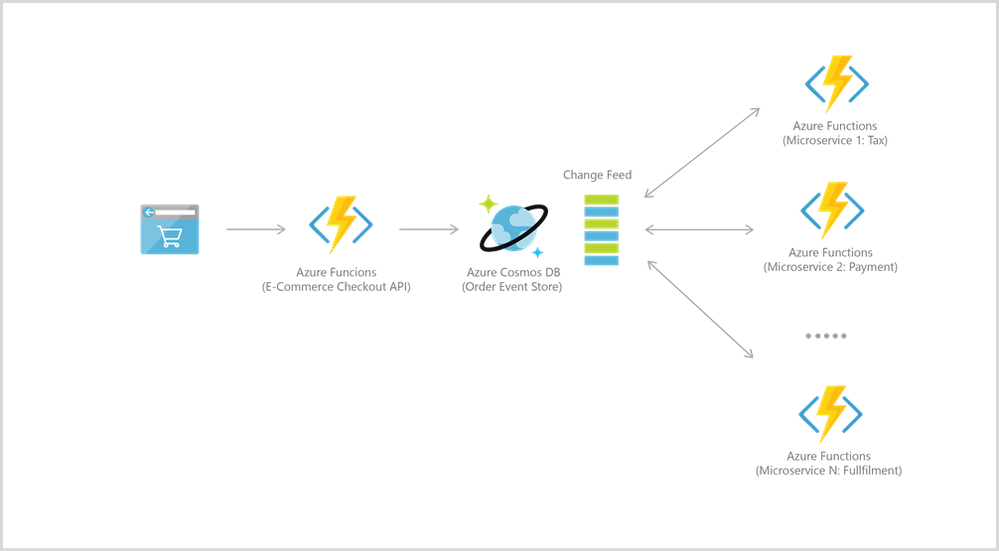
Event-driven architecture
One of the more common event patterns is when a customer places an order on an e-commerce site. When an order is placed, an event is created with all the information necessary for other services to carry out the completion of the order. The task of completing the order would involve several actions that would be processed by different systems: payment is processed, an email is sent to a customer, inventory is accounted for, the shipping label is produced, etc. These actions occur asynchronously so services do not have to wait on another to complete their task.
When you should use this architecture
Use cases for event-driven architecture are typically driven by the need to have near real-time processing and multiple subsystems processing the same events. Many of the common applications include IoT applications, e-commerce, financial systems, and data analytics.
The decision to use a request-driven vs event-driven architecture ultimately boils down to what problem are trying to solve and how you will benefit from the solution. Event-driven is not the answer for all scenarios however it is a great first step to begin thinking about business-processes as first-class events that ultimately derive customer value.
Summary
Transitioning to an event-driven architecture is an opportunity to modernize your systems to keep up with the fast-changing business environment. Paired with a serverless infrastructure, event-driven architecture provides the agility necessary to scale on-demand and independently make changes or update services.
In the next blog in the series, I will focus on how you can build event-driven applications using common messaging patterns and capabilities in Azure.
To learn more about event-driven architecture on Azure, check out Event-driven architecture.
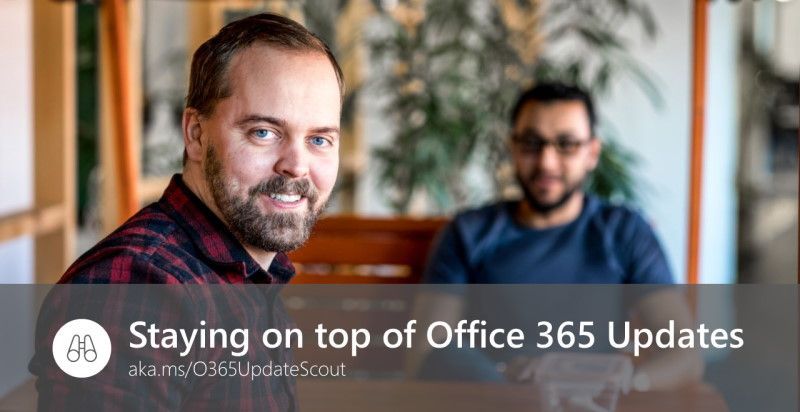
by Contributed | Jan 28, 2021 | Technology
This article is contributed. See the original author and article here.

One of the main challenges when using Office 365 products and services is to stay aware of announcements, updates and upcoming features. This applies to all responsible roles at Office 365 customers as well as for IT Consultants or Engineers guiding others.
This article, written by two Microsoft Customer Engineers (formerly known as Premier Field Engineers), provides an overview of choices, how to gain information and awareness on upcoming changes in Office 365. Different options, tools and services with their respective audience are compared with each other to help to decide what approach best suits the target audience’s needs.
At the end of this post you will find background information to get a general understanding what “evergreening” means, how updates work and why you should adjust your service management processes.
Download this article: O365 Update Scout to go
Grab the PowerPoint version of this article at aka.ms/O365UpdateScoutToGo and share it with anyone who should not be missing changes in Office 365.
Possible options how to stay ahead
There are various ways to keep yourself informed about what is happening in Office 365. Read about some of them below. Be aware that this list is not claiming to cover all existing options or information sources. This list is based on our experience as Office 365 engineers working for multiple customers. Do you know about additional sources, tools or solutions that are missing in this post? Speak up in the comments and let the authors know about it.
Microsoft 365 Roadmap
Publisher:
Microsoft
Source:
Microsoft 365 Roadmap Website:
https://aka.ms/m365roadmap
Description:
The Microsoft 365 Roadmap Website is the official resource for all roadmap related information. Updates usually happen twice a week, related to all products, features and services released across Microsoft 365.
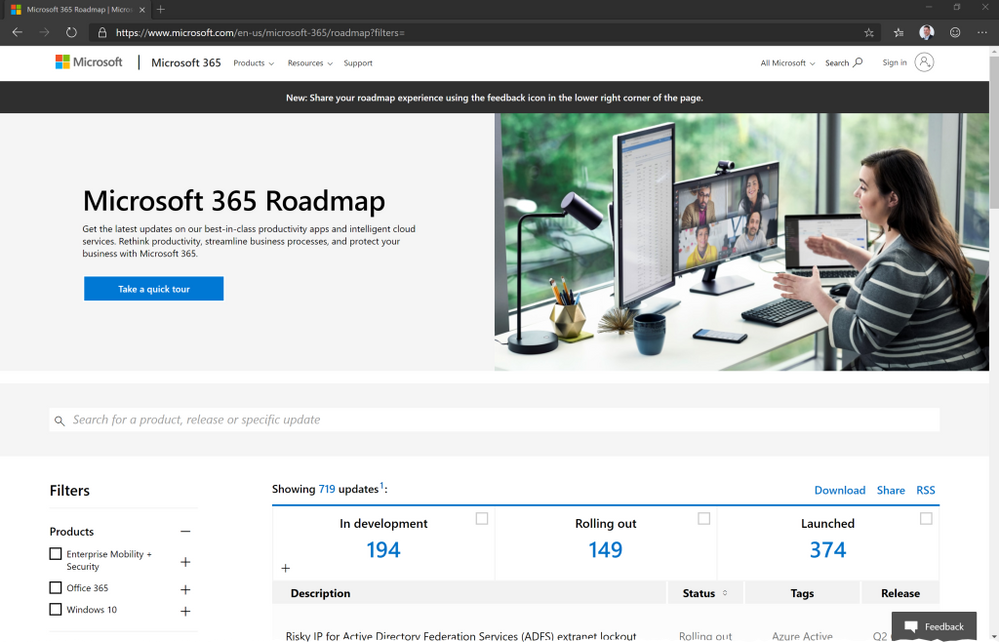
The intuitive website UI, that is offering filtering by certain options and categories, gives access to all roadmap items and their details.
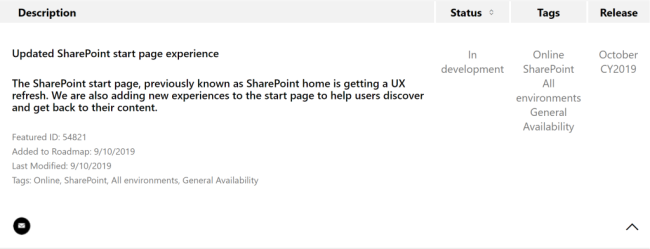
Searching for and sharing of features is possible as well as a download (CSV Format) functionality. An RSS feed subscription is available and recommended for anyone professionally dealing with Office 365.
Conclusion:
The Microsoft 365 Roadmap should be considered “the truth”. It is the official and main channel for all long-term change announcements and should be monitored by most roles dealing with Office 365. Every roadmap item comes with a targeted release estimation, so this is the best way to get information about long term changes or feature updates.
One of the challenges with the Microsoft 365 Roadmap is the release date. Keep in mind that those dates are estimates and subject to change. This doesn’t mean the update or feature will be available within your Tenant at this specific date. The complexity or requirements of a feature, quality checks, feedback while in preview (and more) all those topics can affect the date when a feature will be “really” available within your tenant.
Recommended Audience:
Office 365 Developer
Office 365 Consultant
Office 365 Global Administrator
Office 365 Security Administrator
Office 365 Service Administrator
IT-Service Owner
IT-Change Coordinator
IT-Enthusiast / Power User
Recommended Action:
Create an RSS subscription. You can quickly consume the RSS feed within a Microsoft Teams channel as well (Using Teams RSS Connector or via Flow). If necessary, you can easily search and export roadmap items on the website.
Microsoft 365 Roadmap Watch
Publisher:
Joe Palarchio, Microsoft Employee
Source:
Project Website:
https://www.roadmapwatch.com
Description:
This project helps monitoring the Official Microsoft Office 365 Roadmap and tracks changes that occur with each roadmap update. Changes can be reviewed via the “Browse by Feature” section of the site. You can subscribe to an RSS feed to get notified when updates occur.
The website offers a great way to keep track of chances in the Office 365 Roadmap. Author of the project is Joe Palarchio. He is a Microsoft employee, but the project itself is not affiliated with Microsoft.
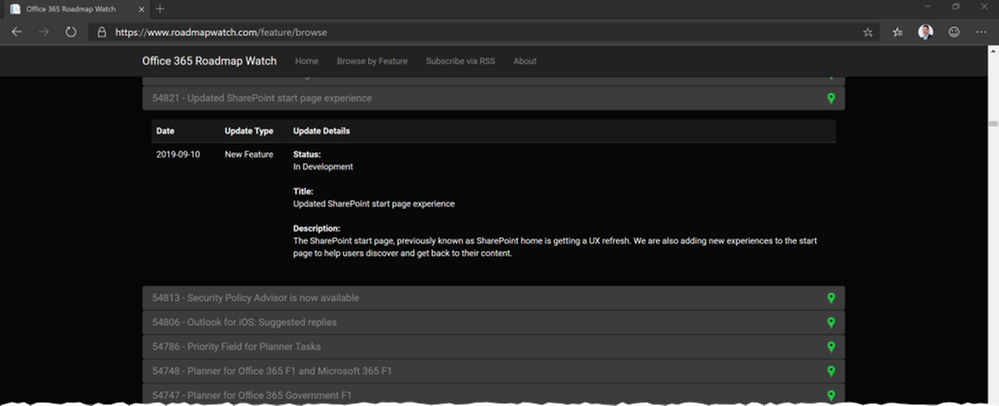
Conclusion:
Keeping track of the official Office 365 Roadmap alone can be challenging, due to the amount of changes. Roadmap Watch simplifies monitoring the roadmap. This solution helps to aggregate roadmap updates and does not provide further information on the roadmap item itself.
Recommended Audience:
Office 365 Developer
Office 365 Consultant
Office 365 Global Administrator
Office 365 Security Administrator
Office 365 Service Administrator
IT-Service Owner
IT-Change Coordinator
IT-Enthusiast / Power User
Recommended action:
Create an RSS subscription and use the Browse by Feature section of the project website.
Office 365 Message Center
Publisher:
Microsoft
Source:
Office 365 Message Center. Microsoft Documentation:
https://docs.microsoft.com/en-us/office365/admin/manage/message-center
Description:
To learn about upcoming changes, including new and changed features, planned maintenance, or other important announcements affecting your tenant, go to the Message center within your tenants admin center. That’s the channel where Microsoft communicates to you or posts official announcements and let you take a proactive approach to change management. Each post gives you a high-level overview of a planned change and how it may affect your users, and links out to more detailed information to help you prepare.
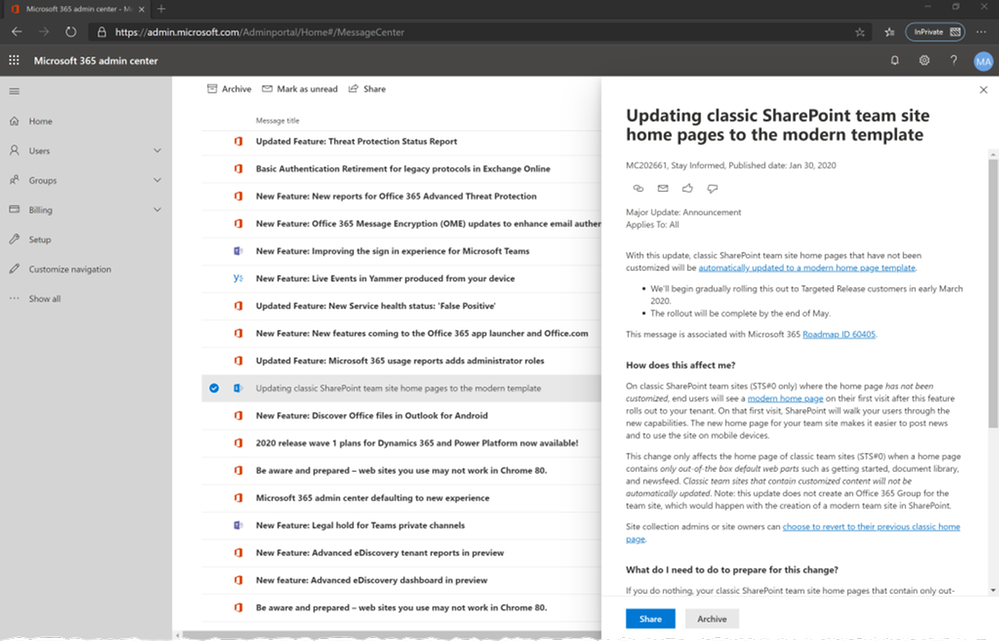
The Message Center preferences offers the ability to send out weekly email digest as well as emails for major updates and data privacy messages. Administrators with access to the Message Center should subscribe this type of emails. A best practice is to create an email distribution list, that receives weekly digest mails. Members of this email distribution list, that have no access to the Message Center itself, can participate from this channel as well.
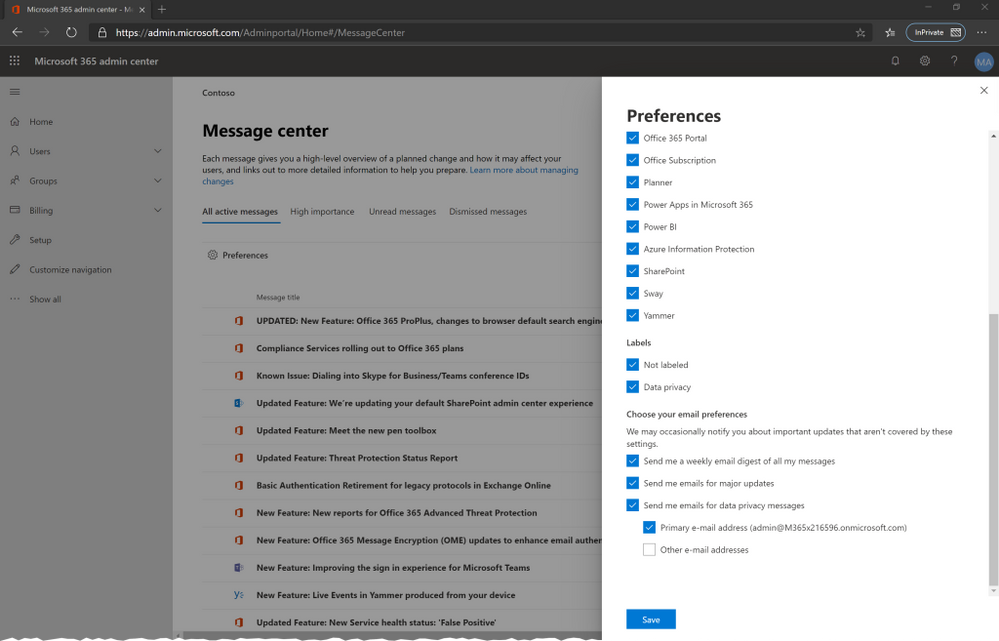
You can also use the Microsoft 365 Admin app on your mobile device to view Message center, which is a great way to stay current with push notifications.
Conclusion:
Depending on your role and permissions, you should monitor your tenants Message Center constantly. Check the list of administrative roles, that do not have access to the Message Center. Even though you can configure Email alerts and digest messages, the amount of data available can make it difficult not to lose the overview. A general monitoring strategy should be discussed with other administrators in your organization.
Recommended Audience:
Office 365 Developer (Weekly Digest Email)
Office 365 Global Administrator
Office 365 Security Administrator
Office 365 Service Administrator
IT-Service Owner
IT-Change Coordinator (Weekly Digest Email)
Business- / IT-Decision Maker (Weekly Digest Email)
Recommended Action:
Get familiar with the Message Center and its features. Go to the Message Center Preferences and configure a weekly email digest and email alerts for major updates. Discuss possibilities to monitor Message Center content within your organization. Review additional tools and solutions (mentioned in this article), that can help to implement an efficient Message Center monitoring.
Office 365 Service Communications API
Publisher:
Microsoft
Source:
Office 365 Service Communications API reference:
https://docs.microsoft.com/en-us/office/office-365-management-api/office-365-service-communications-api-reference
Description:
Microsoft offers an API, that provides access to various information of Office 365, Yammer, Dynamics CRM and Microsoft Intune cloud services. This enables developers and IT pros to build custom solutions to gather events and messages from the Office 365 Message center as well as to get the current state of Office 365 services. You can use the Office 365 Service Communications API V2 to query following data:
- Get Services: Get the list of subscribed services.
- Get Current Status: Get a real-time view of current and ongoing service incidents.
- Get Historical Status: Get a historical view of service incidents.
- Get Messages: Find Incident and Message Center communications.
There are various projects that make use of this API. It can also be used to support your Office 365 information and change management processes by creating your own solution that leverages the API.
A good example of an existing solution which uses the API is the O365ServiceCommunications project, available on GitHub. It provides a PowerShell module for retrieving data from the Office 365 Service Communications API. This can be used right away for reporting the health status of your tenant over time, or for alerting when new messages are published in the Message Center. So ideally you would not just extract the messages from the message center but define procedures (like task items, inform advisory boards etc.) to leverage and benefit from the extracted information.
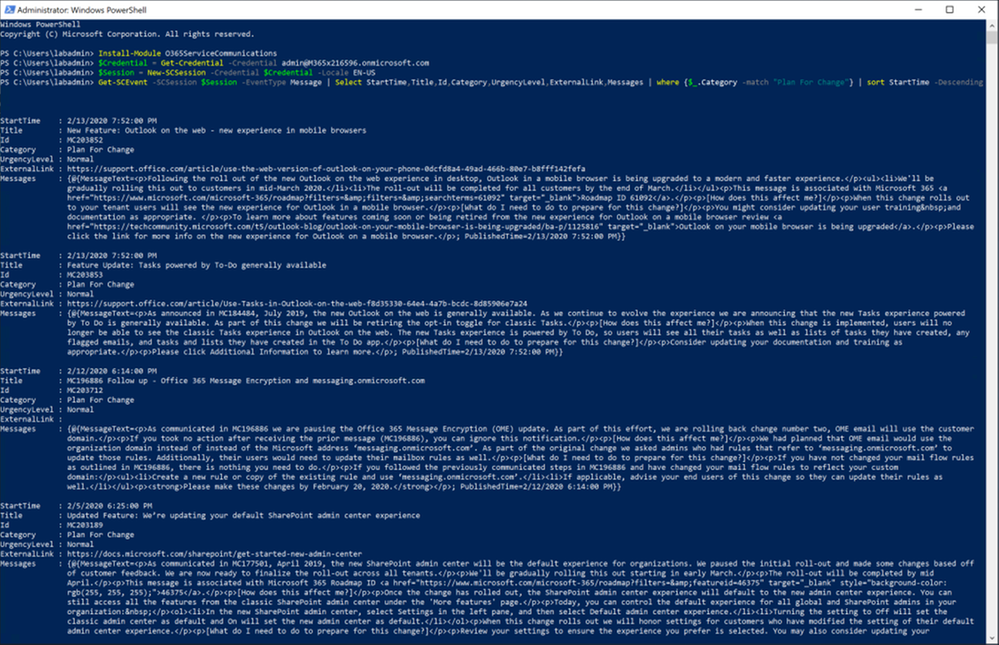
Conclusion:
The Office 365 Service Communications API offers an additional source of information that can be used by administrators or developers to create your own solution and help your organization to get the information you need to be prepared for upcoming changes.
Recommended Audience:
Office 365 Developer
Office 365 Global Administrator
Office 365 Security Administrator
Office 365 Service Administrator
Recommended Action:
If you are looking for possibilities to build a custom solution that is supporting your change management process, Developers or IT pros should take a look at the Office 365 Service Communications API and existing projects building on it.
What’s new with Microsoft 365 Videocast
Publisher:
Microsoft
Source:
YouTube Playlist:
https://www.youtube.com/playlist?list=PLXPr7gfUMmKxJqvWQYhwEXZ8wPp3nkzb0
Description:
What’s new with Microsoft 365 is a YouTube Playlist on the Microsoft Office 365 YouTube channel. Microsoft is releasing a 10-15 minutes videocast at the end of each month, to cover important updates to products, features and services in Office 365. The hosts of the show as well as selected guests highlight certain important updates. The video format offers great possibilities to show details of each topic. Be aware, that not all changes of the last month are covered in each episode.
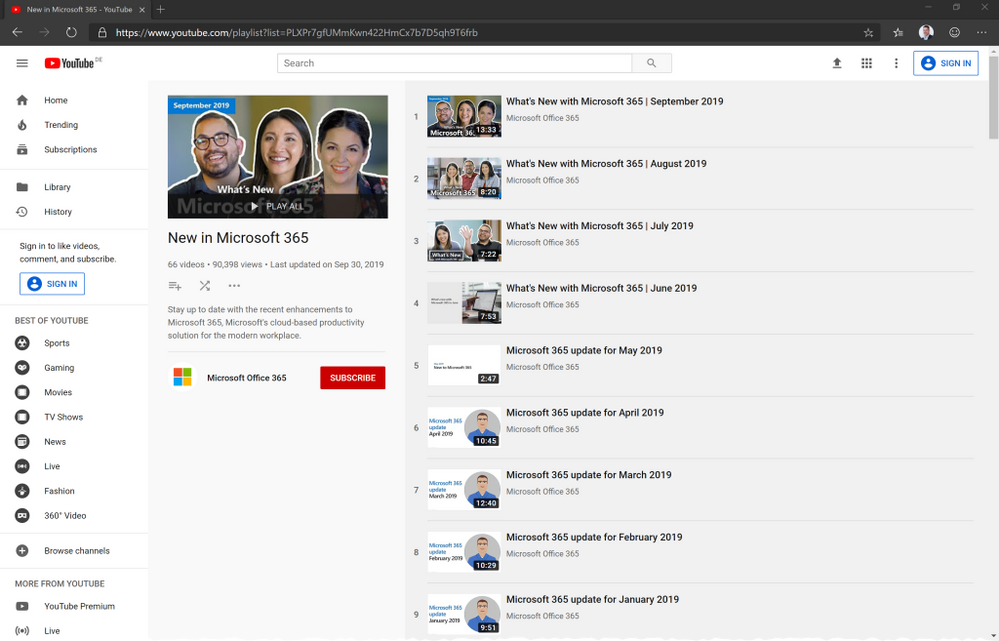
Conclusion:
The videocast format is an easy and quick way to see what is happening in Office 365, on a high-level overview.
Recommended Audience:
Office 365 Consultant
IT-Service Owner
IT-Enthusiast / Power User
Business- / IT-Decision Maker
Recommended Action:
Schedule 15 minutes in your calendar at the end of each month to watch the videocast and catch up with what has happened the last month and how you can benefit from those updates.
Office 365 Automated Change Management
Publisher:
Microsoft Services
Source:
Available for Microsoft Premier/Unified Support Customers.
Contact your Customer Success Account Manager (CSAM), formerly known as Technical Account Manager (TAM) for more information.
Description:
The Office 365 Automated Change Management project is about building a fully automated solution around Azure DevOps (alternatively Planner) and Microsoft Teams as a central collaboration platform within an organization to provide tools to take control and be fully prepared for the changes in Office 365. Administrators, Developers and other responsible roles automatically get the information they need for their workload responsibilities by tasks that are automatically created and assigned to them through this solution.
Message Center Notifications can get posted to Teams for general awareness, even for roles with no access to Message Center. Teams is used to inform about new work items that are linked in the post within the Teams channel:
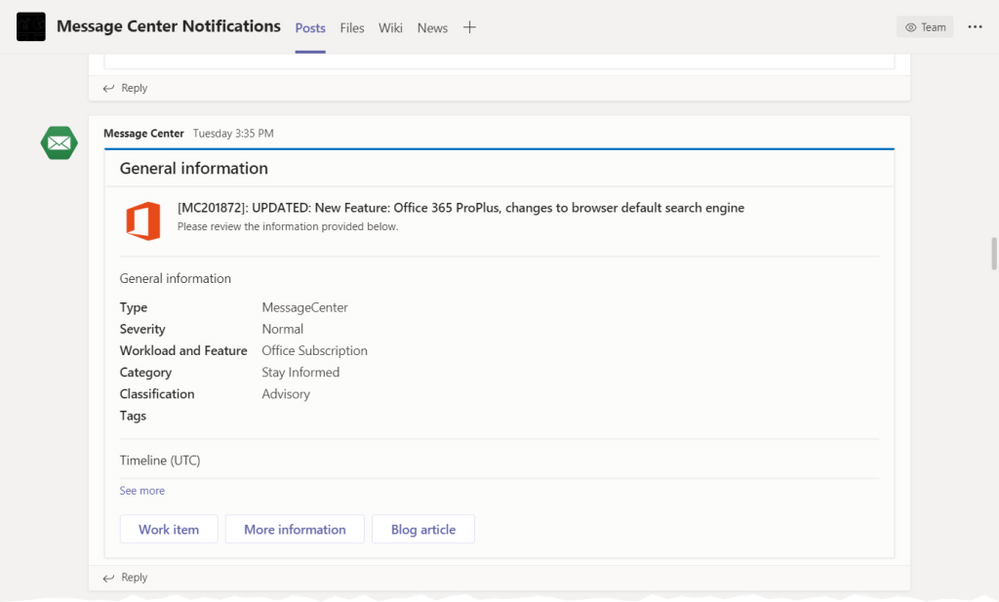
How about Azure DevOps automatically creating work items for any new Message Center notifications? Assign tasks to people in charge and never miss important changes. Not using Azure DevOps? Tasks can alternatively be saved in a Planner bucket as well.
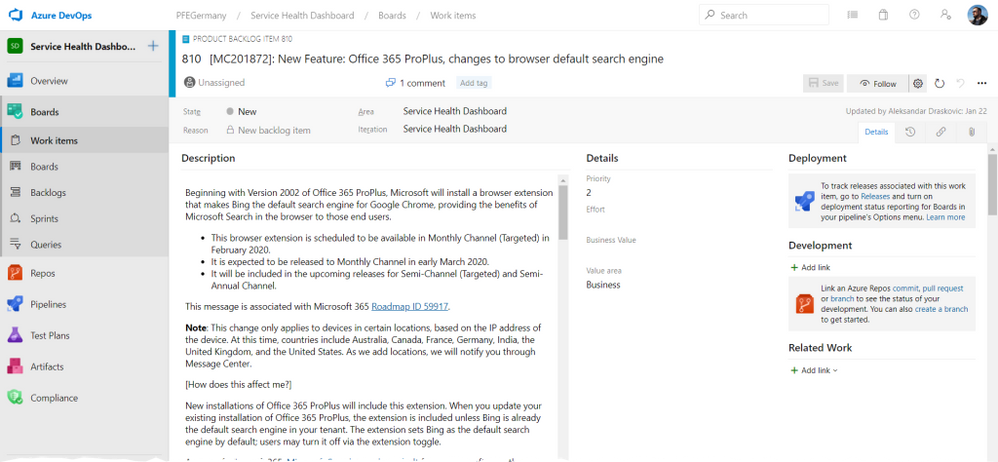
Conclusion:
The solution is an excellent way to automatically create tasks for relevant roles involved in Office 365 Change Management. Organizations that aim for operational excellence and try to improve processes to minimize risks and bad surprises, are recommended to have a look at this project. The solution needs to be implemented and customized by Microsoft Services. The minimal implementation effort pays off immediately.
Recommended Audience:
Office 365 Developer
Office 365 Global Administrator
Office 365 Security Administrator
Office 365 Service Administrator
IT-Service Owner
IT-Change Coordinator
Recommended Action:
If you are Microsoft Services, Premier/Unified Support Customer and interested in implementing this solution, please talk to your Customer Success Account Manager, formerly known as Technical Account Manager (TAM) to get more information about it.
Office 365 Message Center Planner Syncing
Publisher:
Microsoft
Source:
Office 365 Message Center. Microsoft Documentation:
https://docs.microsoft.com/en-us/office365/planner/track-message-center-tasks-planner
Description:
Non-Global Admins or Non-Service Administrators are not able to see the Office 365 Message Center. How about an automated way, that reads the Message Center and posts relevant information to Planner? Message Center Synchronisation to a Planner Plan can be set up in a few minutes.
The idea is reminding us of the Office 365 Automated Change Management solution mentioned earlier in this article. Compared to the Office 365 Automated Change Management solution this is a more simplified approach that just covers basic functionality but is very easy to implement.
Bring over notifications from the Message Center automatically into Office 365 workload related Planner buckets:
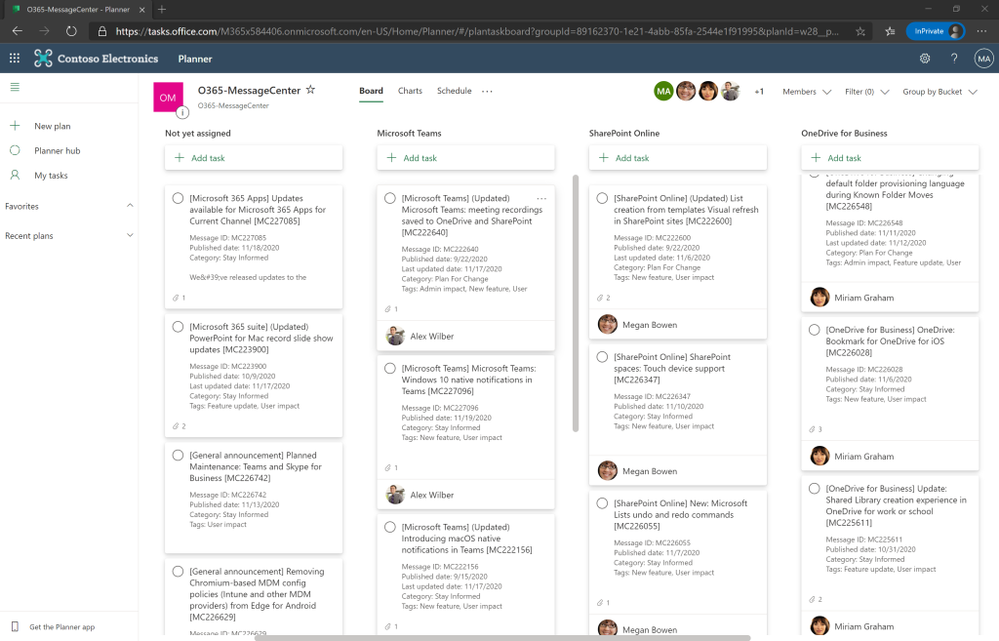
Conclusion:
Similar like the Office 365 Automated Change Management solution from Microsoft Services, Office 365 Message Center Planner Syncing is an easy way to automatically manage changes by syncing Message Center items to a Planner Plan. In the Plan, synced tasks can be assigned to people in charge.
Recommended Audience:
Office 365 Developer
Office 365 Global Administrator
Office 365 Security Administrator
Office 365 Service Administrator
IT-Service Owner
IT-Change Coordinator
Recommended Action:
Work through the Microsoft Message Center Planner Syncing documentation and review the step-by-step implementation guide. Adopt it to fit your organization’s needs.
Monthly Technical Update Briefing
Publisher:
Microsoft Services
Source:
Available for Microsoft Premier/Unified Support Customers.
Contact your Customer Success Account Manager (CSAM), formerly known as Technical Account Manager (TAM) for more information.
Description:
The Office 365 monthly Technical Update Briefing (TUB) is available for all Office 365 workloads (SharePoint Online, Exchange Online, Teams and Skype for Business) and provides IT professionals with proactive information on updates needing change management attention.
TUB delivers the short-and long-term roadmap of future Office 365 capabilities and features:
- Enabling ongoing value of Office 365 investment by receiving knowledge on new features and updates
- Understanding necessary administrative and user actions to implement changes
- Overview on mandatory and optional changes including switches to consider
- Understand infrastructure updates to consider in your hybrid solutions
- Understand delivered bug fixes to update your helpdesk staff
TUB is available in two formats:
Webcast: Office 365 – Technical Update Briefing SharePoint Online / Exchange Online / Teams
The one-hour, monthly workload specific webcast series is presented by a Microsoft Customer Engineer (formerly knows as Premier Field Engineer). It contains information on new features, feature updates and changes, rollout timelines, and further roadmap information. There are separate one-hour webcasts available for multiple workloads (SharePoint Online, Exchange Online and Microsoft Teams) which are not customer specific.
WorkshopPlus: Office 365 – Technical Update Briefing (Dedicated Session 1 Day)
Presented by one or more Microsoft Customer Engineers (formerly known as Premier Field Engineers), the monthly WorkshopPlus is a 6 hours delivery. It contains information on new Office 365 features, feature updates and changes, rollout timelines and further roadmap information. All workloads are included in this session (Overall O365 announcements, Exchange Online, SharePoint Online as well as Microsoft Teams) and targeted specifically to the customer. There are Demos, Q&A and Post-Delivery follow-ups included in this service as well.
Sample content from a former TUB announcement:
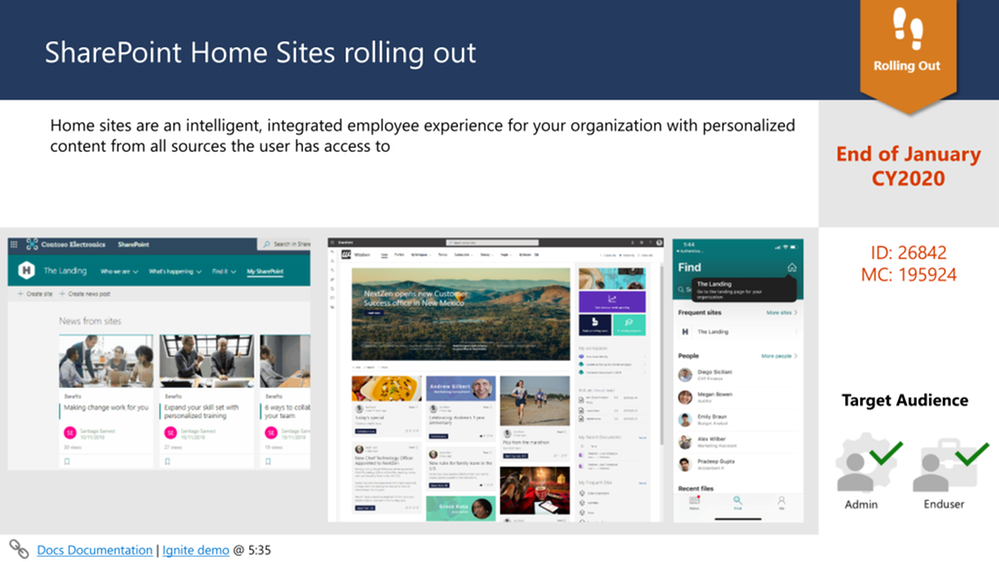
Conclusion:
TUB is a very detailed way to get relevant information to the right audience. The interactive format offers more than just plain news about What’s New. Unique selling point is the possibility to ask the experts (CEs, formerly known as PFEs) during the delivery. Demos, Q&A and follow-ups add the value which Microsoft Enterprise customers are looking for.
Recommended Audience:
Office 365 Global Administrator
Office 365 Security Administrator
Office 365 Service Administrator
IT-Service Owner
IT-Change Coordinator
Recommended Action:
If you are Microsoft Services, Premier/Unified Support Customer and interested in monthly Technical Update Briefings, please talk to your Customer Success Account Manager (CSAM), formerly known as Technical Account Manager (TAM) to get more information about it.
Office 365 Blog
Publisher:
Microsoft
Source:
Office 365 Blog on Microsoft Tech Community:
https://techcommunity.microsoft.com/t5/office-365-blog/bg-p/Office365Blog
Description:
The Office 365 Blog is a great source for best practices, news, and trends. The product groups as well as other experts from the field (e.g. Engineers from Microsoft Services) publish content that is relevant for everyone dealing with Office 365.
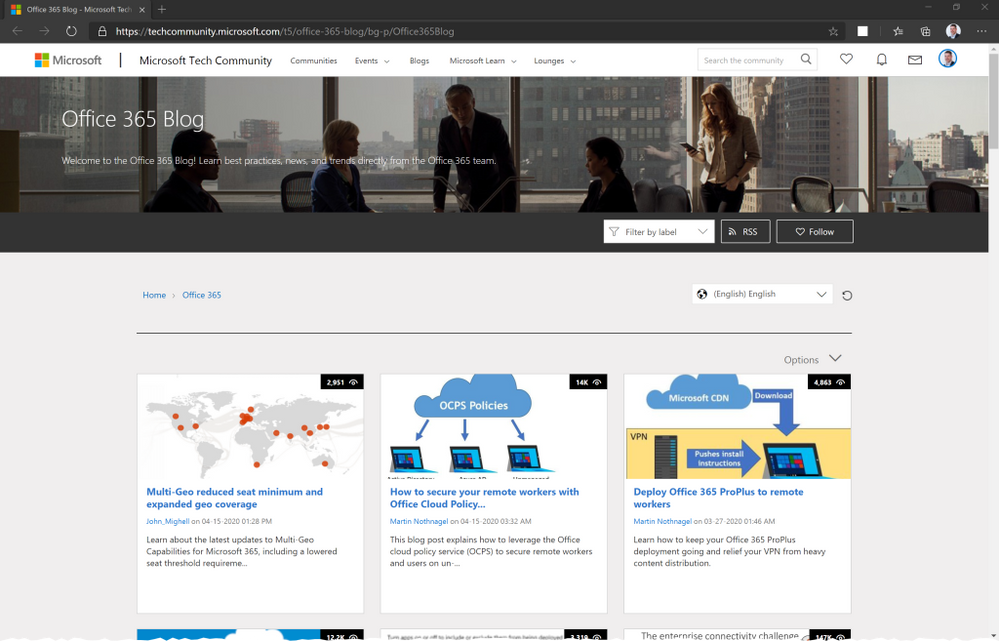
Conclusion:
There is a variety of Office 365 related Blogs on Microsoft Tech Community. Workloads like SharePoint, Teams or Exchange are covered by dedicated blogs, but by following the Office 365 Blog you make sure to get information across the board.
Articles that are published here are not just announcing latest updates or the availability of important features, but also delivering other must-know content. For that reason, you should not miss the pieces created by subject matter experts.
Recommended Audience:
Office 365 Developer
Office 365 Consultant
Office 365 Global Administrator
Office 365 Security Administrator
Office 365 Service Administrator
IT-Service Owner
Business- / IT-Decision Maker
Recommended Action:
Create an RSS subscription. You can quickly consume the RSS feed within a Microsoft Teams channel as well (Using Teams RSS Connector or via Flow).
Role Guide: How can you stay ahead?
Different roles and responsibilities, different access to information sources, different point of view. In this section you find typical roles involved in the Office 365 game.
Select to find out which options could make sense for you:
Select your Role
Office 365 Developer
Office 365 Consultant
Office 365 Global Administrator
Office 365 Security Administrator
Office 365 Service Administrator
IT-Service Owner
IT-Change Coordinator
IT-Enthusiast / Power User
Business- / IT-Decision Maker
Options Matrix
See all the options described in this article in one overview. Which role are you in?
Find out what is recommended for you to stay on top of Office 365 Updates.
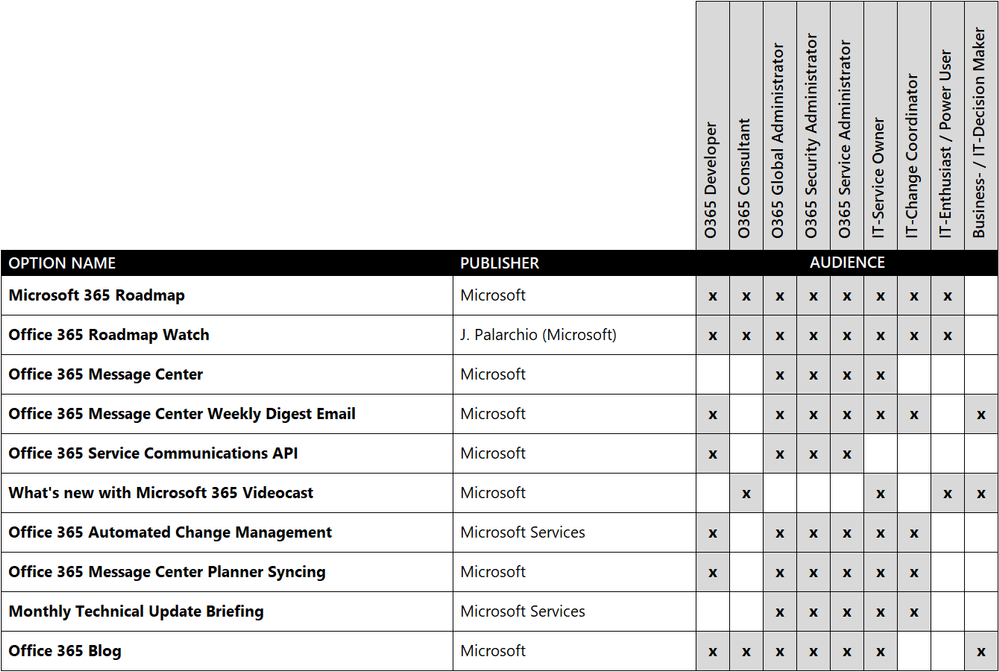
Conclusion
As you might have guessed by now, there is simply no one-fits-all solution for this topic. Different Office 365 customers use multiple ways to deal with upcoming changes.
Look out for future blog posts covering real world customer examples from the field.
In our experience customers use a mixture of the options above to stay ahead of upcoming changes. Important factor to mention is not only to getting the information ahead of the update but to leverage this information proactively. Customers tend to “ignore” updates which first is not a proper way to deal with it. Furthermore, it is a bad decision because every month new features and updates will appear on top of the ignored ones within the tenant. And don’t forget, your users will use those features so staying aligned and proactive is in your organization and your users’ best interest.
Our hope is that every one of you will take action to
- Consume the information from Office 365 blogs, roadmap, and Message Center etc.
- Review the communications for business benefit and to avoid adversity with your business users
- Drive and measure business benefits of each new feature because success begets success like nothing else
BACKGROUND INFORMATION
|
The Microsoft 365 change guide
Microsoft published an excellent online resource that is a must read for the audience of this article.
The Microsoft 365 change guide helps understanding the concept of rapid feature release and adoption and why it is necessary to develop and implement a robust change management strategy. The documentation is structured in chapters to provide background information as well as giving advisory for customers to implement modern IT service and change management:
Continuous change in the cloud
Introduction to the Microsoft agile development model and how customers benefit from Microsoft being committed to constantly enhance, improve, and evolve cloud services.
Read more (Continuous change in the cloud)
Controlling change: challenges and strategy
An overview of challenges customers are facing with the continuous release policy of Microsoft 365. Learn about the impact your strategy can have on evergreen IT. Three categories of customers can be identified based on their observed change strategies. Read about these common approaches and what Microsoft is advising.
Read more (Controlling change: challenges and strategy)
Service release channels and controls
Microsoft 365 customers can control the release of features they receive in two different options: “Standard Release” and “Targeted Release”. The implications of these different types are covered in the guide. Furthermore, Microsoft develops and releases new features in a ring deployment model while every ring reaches a broader audience.
Get familiar with the service release channels and how to set up the release option in the admin center.
Read more (Service release channels and controls)
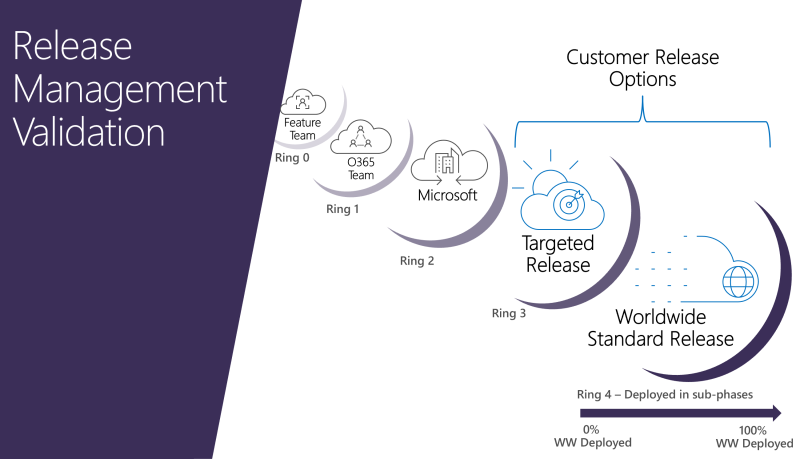
Figure taken from the Microsoft 365 change guide
Client release channels and controls
To be able to manage changes on client devices, organizations must understand the concept of client release channels. The documentation compares the differences of Microsoft 365 Apps channels (Current Channel, Monthly Enterprise Channel and Semi-Annual Enterprise Channel) and how to modify update channels for devices in your organization.
Read more (Client release channels and controls)
Change evaluation democratization
Get insights about options on update evaluation and testing and how Microsoft IT internally is dealing with this topic.
Read more (Change evaluation democratization)
Microsoft change plans, policies, and procedures
Updates are necessary to keep products and services secure, up to date, and working as expected. The M365 change guide is transparent in explaining the Microsoft 365 change management plan, disclosing details on the three phases of a change. The article explains how changes are classified and about Microsoft’s commitment to notify customers before updates are rolled out.
Read more (Microsoft change plans, policies, and procedures)
The Microsoft 365 change guide
https://docs.microsoft.com/en-us/deployoffice/fieldnotes/microsoft-365-change-guide
|
Version History
Version 1.4 (2021-01-28)
Version 1.3 (2020-11-19)
Version 1.2 (2020-04-30)
Version 1.1 (2020-03-13)
Version 1.0 (2020-03-02)
About the Authors
This content was published by Christian Heim and Christian Keller. Both work for Microsoft in Germany in their role as Senior Customer Engineers. Check out this video to find out what their daily business is all about: Working as a Customer Engineer (Premier Field Engineer) at Microsoft.
Disclaimer
The authors of the Office 365 Update Scout online article and offline PowerPoint document are a group of Microsoft Customer Engineers (CEs), formerly known as Premier Field Engineers (PFEs). The Office 365 Update Scout should not be considered an official (Microsoft) product. It was created and published to help Office 365 Administrators to stay aware of announcements, updates and upcoming features. All information provided in the Office 365 Update scout online article and offline PowerPoint document is provided “AS IS” with no warranties and confers no rights. The Office 365 Update Scout online article and offline PowerPoint document does not represent the thoughts, intentions, plans or strategies of Microsoft. All content is solely the opinion of the authors and provided with a best effort to be based in reality. All content, code samples, demonstrations, or anything resembling a “how-to” are provided “AS IS” without warranty of any kind, either express or implied, including but not limited to the implied warranties of merchantability and/or fitness for a particular purpose.


Recent Comments